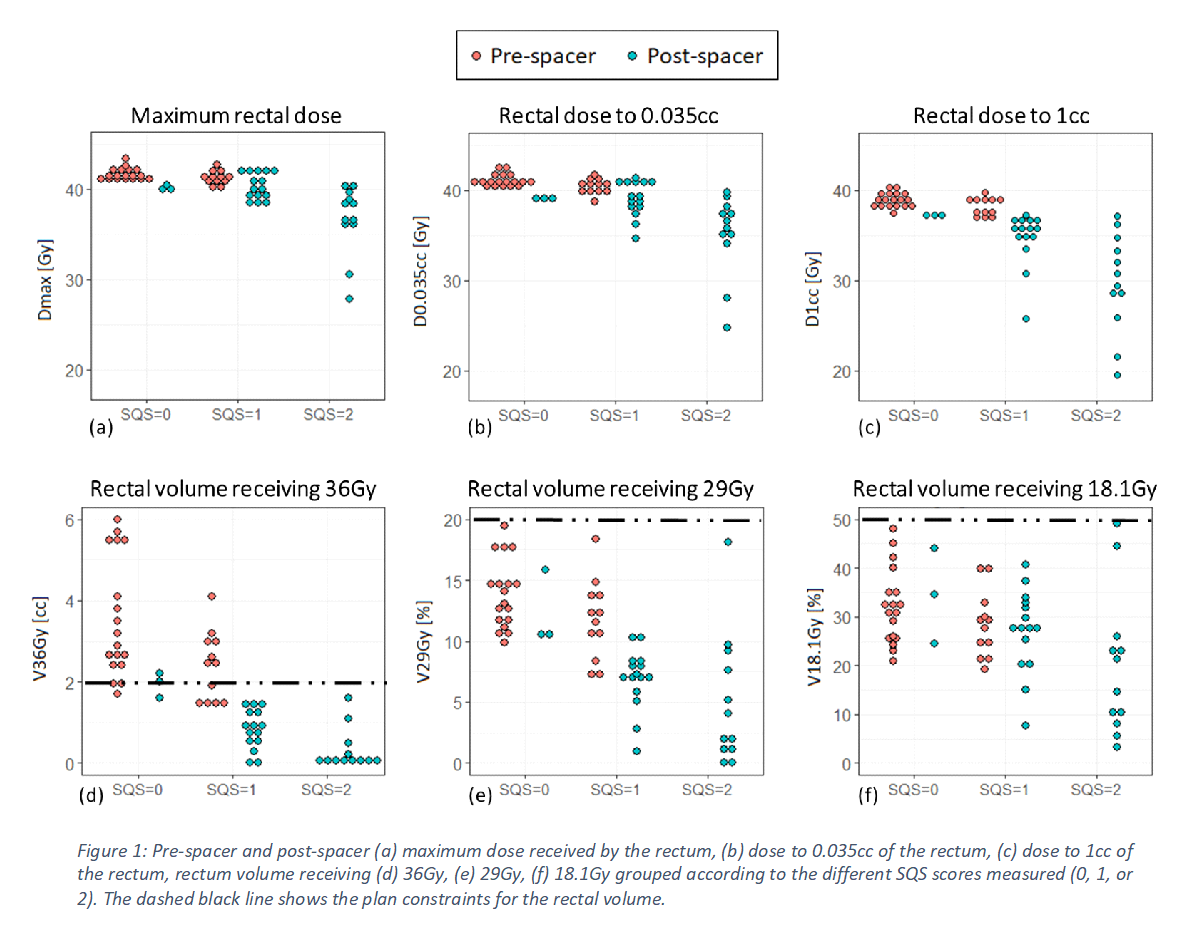Validation of a quality score assessing the spacer placement in patients treated with prostate SABR
Conor McGarry,
United Kingdom
PO-1998
Abstract
Validation of a quality score assessing the spacer placement in patients treated with prostate SABR
Authors: Valentina Giacometti1, Patrick Comiskey2, Hannah Marshall3, Orla Houlihan3,4, Glenn Whitten2, Kevin M Prise3, Alan R Hounsell3,2, Suneil Jain3,4, Conor K McGarry3,2
1Queen's University Belfast, Patrick G. Johnston Centre for Cancer Research, Belfast, United Kingdom; 2Northern Ireland Cancer Centre, Department of Radiotherapy Physics, Belfast, United Kingdom; 3Queen’s University Belfast, Patrick G. Johnston Centre for Cancer Research, Belfast, United Kingdom; 4Northern Ireland Cancer Centre, Department of Clinical Oncology, Belfast, United Kingdom
Show Affiliations
Hide Affiliations
Purpose or Objective
The aim of this study was to evaluate the quality of the interspace between prostate and rectum and assess the impact on the dose to the rectum by measuring the spacer quality score (SQS) before and after implanting a hydrogel rectal spacer.
Material and Methods
A cohort of 30 prostate cancer patients treated with prostate stereotactic ablative body radiotherapy (SABR) as part of the SPORT clinical trial [1] was selected for this study. Each patient had a 10 ml polyethylene glycol hydrogel spacer inserted transperineally under transrectal ultrasound guidance. CT scans were acquired prior to spacer insertion (pre-spacer CT) and a week following spacer insertion (post-spacer CT), and two 10MV SABR treatment plans (pre- and post-spacer insertion) were generated. In order to calculate the overall SQS as described in [2], the prostate-rectal interspace (PRI) was measured in the anterior-posterior orientation, parallel to anatomic midline at the prostate base, apex, and midgland on the pre-spacer and post-spacer CTs. Differences between pre-spacer and post-spacer PRIs and SQS were investigated by performing Fisher’s exact test and statistically significant differences between dose to the rectum were investigated by performing the paired samples Wilcoxon test and t-test.
Results
Statistically significant differences between pre-spacer vs post-spacer patients were found when grouping patients according to their SQS with 60.0% vs 10.0%, 40.0% vs 50.0% and 0.0% vs 40.0% having a scores of 0, 1, and 2, respectively. Statistically significant differences in the dose to the rectum (maximum dose to the rectum, dose to 0.035cc and 1cc of the rectum, volume of rectum receiving 18.1Gy, 29Gy, and 36Gy) were measured when grouping patients according to their PRIs and SQS (p-value<0.05). Figure 1 presents a summary of the dosimetric results (Dmax, Rectal D0.035cc Rectal D1cc, Rectal V40Gy, Rectal V30Gy) of pre-spacer and post spacer patients. The results show that lower doses to the rectum correspond to higher SQS scores. The differences are statistically significant for all the measurements presented (p-value < 0.05).

Conclusion
This study confirms the value of implementing a quality score to evaluate the quality of the hydrogel spacer in prostate cancer patients. The score before and after the spacer insertion was evaluated and it was found to be associated with rectal dosimetry.
Bibliography
[1] F. Ciaran et al., “The stereotactic prostate radiotherapy (SPORT) trial: A randomized feasibility study comparing prostate SABR to prostate and pelvic nodal SABR,” J. Clin. Oncol., vol. 39, no. 6_suppl, p. 248, 2021, doi: 10.1200/JCO.2021.39.6\_suppl.248
[2] C. E. Grossman et al., “Quality Metric to Assess Adequacy of Hydrogel Rectal Spacer Placement for Prostate Radiotherapy and Association of Metric Score With Dosimetric and Gastrointestinal Toxicity Outcomes,” Int. J. Radiat. Oncol. Biol. Phys., vol. 111, no. 3, p. e507, 2021, doi: 10.1016/j.ijrobp.2021.07. 1393.